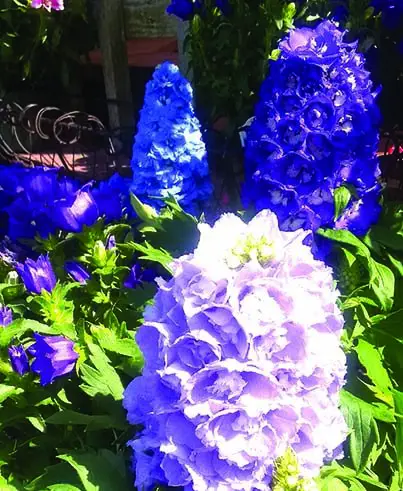What is blue? The sky is blue, the ocean is blue, but only a handful of flowers are true blue.
Why do gardeners like the color blue? I owned a small greenhouse in Upstate New York years ago and sold my plants at a local farmers market. Next to my flower stand was another vendor, who sold delphiniums with towering stalks of tri-color blue that made everyone stop in their tracks. These true-blue perennials always sold out before day’s end, and I asked her about the plant. “People love blue, if you can grow a blue plant, customers will buy it!”
While preparing my farm stand for Mother’s Day that same year, I transported 20, 5-foot delphiniums to my house, preparing for a sale. I set them outdoors, but that night, on May 10, it snowed! But I awoke to find the tall beauties only slightly tinged, and we sold out that weekend.
I have been researching blue and purple plants for years and turn to the masters of color for advice. I had the good fortune of receiving an amazing gardening book from my parents who visited France. “Monet’s Passion: Ideas, Inspiration and Insights from the Painter’s Garden,” by Elizabeth Murray, which combines Claude Monet’s paintings and his Giverny gardens in France, has been an inspiration for me.
The historic Monet gardens have been lovingly maintained, and the book’s author worked on the site in the 1980s. Her meticulous records and drawings can assist any garden in transforming into a large or small duplicate of this magnificent setting.
When I moved to California, I had the pleasure to be in touch with Elizabeth in Monterey, where she maintains an artist studio and teaches online classes at elizabethmurray.com.
As I read and reread her book on Monet, I discovered many of the secrets that the artist applied to his gardens. “Using blue with clear yellow was one of Monet’s favored color combinations, and painted reflex yellow tulips to emerge from a carpet of sky-colored bluebells. (Monet even designed china in yellow, blue and white to be used for special occasions in his yellow dining room that was decorated with blue accents.)”
So, dear gardener, I have compiled a list of “true blue plants,” and yellow/orange accompaniments that will set your garden on fire! Some of the suggestions can be purchased as starter plants, whereas others are started from seed. I suggest going online to purchase specialty seeds from rareseeds.com or botanicalinterests.com. And take this list with you to the garden center, so you can find the varieties that will fill your garden plan.
BLUE PLANTS
• Delphinium — These 4- to 5-foot wonders produce for months — Blue Butterfly, White Bee and Magic Fountain.
• Balloon Flower — Its unique structure enables the blooms to expand and open, like a balloon, into a blue starflower.
• Love-in-the-Midst — This highly unusual annual produces multicolored blooms with star-shaped green centers.
• Lobelia — Tiny blue blossoms cascade on green sprawling stems with tiny white centers.
• Morning Glories — These blue ever-bloomers are worth the effort to grow from seed. Special order to find Keiru Mountain Stream, Mura Kumo and Kikyozaki varieties from Japan.
• Black Hollyhock — These dark blue beauties are often found towering to 6 feet tall in cow pastures with seed transported by birds that feed on cowpies!
YELLOW/ORANGE PLANTS
• Black-Eyed Susan Vine — The perfect next-door neighbor for the towering hollyhock, this multicolored vine sprouts orange and yellow flowers.
• Calendula — This brilliant yellow/orange annual is easy to grow from seed or purchase as a seedling.
• Marigolds — These old standbys are now found in a huge variety of starter plants, or grow from seed.
• Nasturtium — These sprawling beauties have the bad reputation as being invasive, but let’s face it, a packet of nasturtium seed produces the cheapest ground cover on the block! Special order these varieties — Tip Top Alaska, Orchid Cream and Bloody Mary.
• Sunflowers — Once again, I like to feature the best bargain choices, so purchase sunflower seed in the largest packet you can find. Mammoth, Gold Coin (multi-bloom) and Orange Mexican Sunflower will add height to any plot. Also try Black Oil Sunflower Bird Seed, which is found in the bird seed aisle.
FIND A COLOR WHEEL
Although we don’t have room to print one here, you can have great fun while planning and purchasing flowers for your garden by locating a color wheel. Artists have been using these for years, and since I am also a painter, I discovered the blue with yellow combination while studying color theory.
FINAL DESIGN THOUGHTS
“In creating the perfect landscape we are imitating nature. Monet’s gardens serve to teach us that in gardening we have an opportunity to work with natural elements, in an artistic, organized manner. Just as a successful landscape painting uses an organization of colors to give an illusion of a three-dimensional reality, so does garden design employ specific shapes and placement of color to create depth, exaggerate light and shadow, and bring into being the inner vision of its creator.” (From “Monet’s Passion”)
I hope you all have great fun planning and planting your flower gardens this spring. Please contact me for additional plant suggestions and design ideas at [email protected].
Jano Nightingale is a Master Gardener, garden designer and teacher who lives in Vista.



